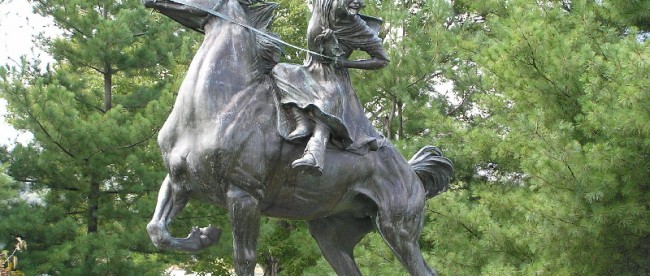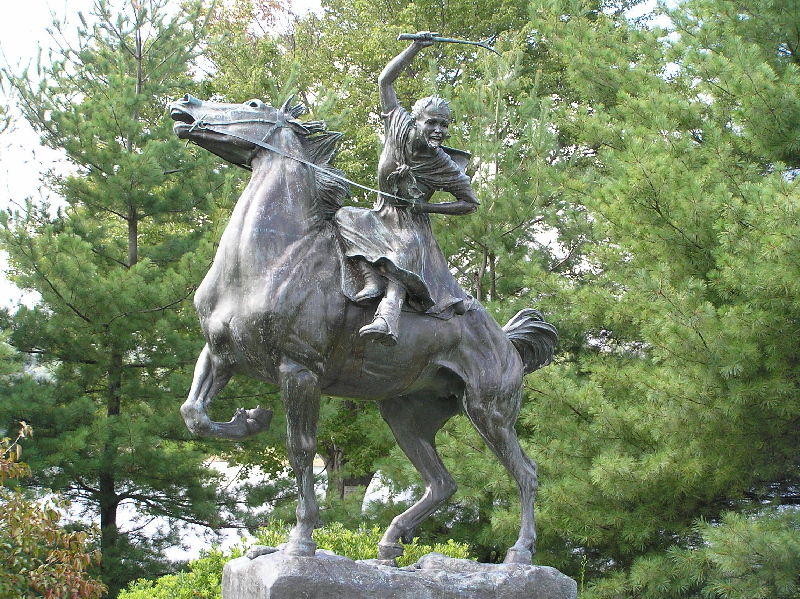The Midnight Ride of Sybil Ludington


The American poet Henry Wadsworth Longfellow was born Maine in 1807, which is to say that he wasn’t around to witness the American Revolution. Nevertheless, in 1860 — as the nation became increasingly fractured and ultimately, fell into war once again — Longfellow wrote and published “Paul Revere’s Ride.” The poem recounts the heroism of patriot Paul Revere, who famously (in part because of the poem itself) rode into the night to warn the American troops that British troops had mobilized.
The poem has a lot of historical inaccuracies too numerous to list here. (That said, Wikipedia’s summary is solid.) A notable one, though, is that Revere wasn’t alone that night — he was joined by two others, William Dawes and Samuel Prescott. Only Dawes (not Revere) succeeded on the mission; Prescott fell from his horse and Revere was captured. But regardless, when one thinks of midnight rides to warn the Revolutionary Army of incoming British troops, one typically thinks of that April 18, 1775 ride.
The war, however, continued onward for years — and in at least one other occasion, a similar feat was warranted. In April of 1777, British soldiers had reached the city of Danbury, Connecticut, burning much of it to the ground. Reports of the attack reached Dutchess County, New York, about thirty miles west of Danbury. Dutchess County’s militia, though, had all gone back to their farms and homes in preparation for the spring harvest. The duty of gathering the militia fell to Colonel Henry Ludington of Kent, New York, but neither he nor the rider who brought him news of the assault on Danbury could gather the militiamen. As the National Women’s History Museum explains, “the rider [who brought the message] was too tired to continue and Colonel Ludington had to prepare for battle.” Someone had to step in.
The next set of details get murky — there are no contemporaneous reports, which unfortunately isn’t uncommon given the time period. Col. Ludington, the story goes, determined a midnight ride was warranted — one which would be twice as long as Revere’s, through more hostile terrain, and arguably in an area with more people still loyal to the Crown. It was a thankless, dangerous job, but Ludington’s 16-year-old daughter, Sybil, voluntreed. With few other options in sight, her father agreed, and Sybil traversed Dutchess County, mustering up the militia. Mental Floss summarized the ride:
[Sybil] knew the area and knew where members of the militia lived. Sybil rode her horse from her father’s farm in Kent, which was then called Frederick. She first headed south to the village of Carmel and then down to Mahopac. She turned west to Mahopac Falls and then north to Kent Cliffs and Farmers Mills. From there, she rode further north to Stormville, where she turned south to head back to her family’s farm. All told, she rode nearly 40 miles through what was then southern Dutchess County (which is now mostly Putnam County).
Sybil spent the night traveling down narrow dirt roads in the rain with nothing but a stick as protection. To add another element of danger, there were many British loyalists in the area and more than a few “Skinners,” a word generally used then to describe an outlaw or ruffian who had no real loyalties to either side in the war. One account of her ride says that Sybil used her stick to pound on a Skinner who accosted her.
In total, Sybil gathered nearly 500 troops to the cause. The Dutchess militia joined other American soldiers and met British troops near Ridgefield, Connecticut. The British won the Battle of Ridgefield but the victory was hollow, as many Connecticut colonists were emboldened at the valor of their future countrymates.
A statue, above, commemorating Sybil’s ride can be found in Carmel, New York.
Bonus fact: Paul Revere was a dentist by training and, by historical accident, is sometimes considered the first to practice forensic dentistry (although that’s a stretch). Revere’s friend, General Joseph Warren, died in the Battle of Bunker Hill and was buried in a mass grave. Revere was able to identify Warren’s body “because he had placed a false tooth in Warren’s mouth, and recognized the wire he had used for fastening it,” per Wikipedia.
From the Archives: The First American Flag Was Very British Looking: Really, it was.
Related: “Sybil Ludington’s Midnight Ride,” a book for elementary school kids about the Revolutionary heroine. 4.5 stars on 25 reviews.
